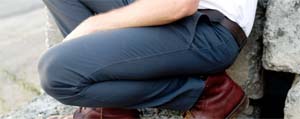In the past couple of years there has been a lot of talk about nanotechnology and stain resistant pants. Yes they exist, a real product of nanotechnology.
One of the most popular nanotechnological processes for making stain-resistant fabric was developed by a company called Nanotex. They don’t make fabric but they make a process to treat fabric. It involves a chemical treatment of the fabric to create a surface that repels water and also repels oil. Most stains come to you as liquids (like orange juice). The first step to getting a stain on your pants is to spill something on them and have the liquid sucked up into the fabric. Then the liquid dries up and you have a stain. If you can keep the liquid from getting sucked up, well you can prevent a stain from happening.
So how do you make a fabric stain resistant? For a long time you could buy stuff that could be sprayed onto your pants. This stuff worked like a grease that would prevent most stains from getting sucked up into the fabric. The problem is that after a few times in the washing machine the stuff would get washed off. Nanotex is different, it uses chemistry to make little tiny whiskers and other things that help to repel liquids. First the fabric is treated with some acid and some hydrophobic polymers are pressed into the fabric. The fabric is then baked to make the whiskers. Supposedly, little tiny whiskers of which about one-thousand can fit across a thread of fabric. That makes them about one thousand nanometers across. The whiskers make the fabric hydrophobic. So, it is part of the fabric and makes the fabric stain repellent. Stains don’t stay and the whiskers don’t wash away either.
The picture on the left shows a before and after of several different foods (water, cranberry juice, mustard, and vegetable oil) left sitting on Nanotex treated fabric for 30 minutes and wiped clean with a wet paper towel.
To try this activity, refer to: Nano-Tex: Testing New Nano Fabrics

